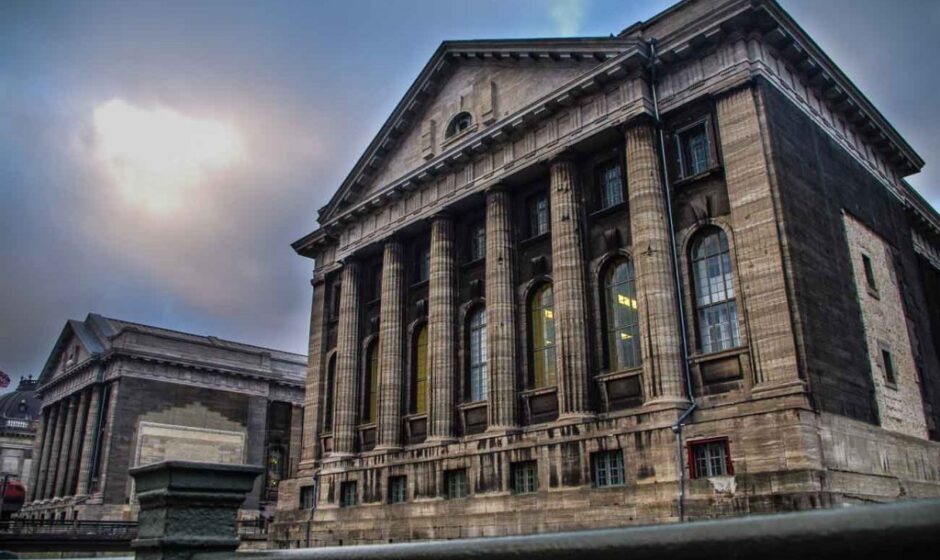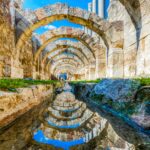ACROPOLIS (Pergamon Museum)
Pergamon is a hill settlement. Urbanism in the city constitutes a unique example of a city order in terms of form and planning, which is largely due to topographic necessity. The absence of a natural flatness in Pergamon made it necessary to gain space by terracing the land from the earliest phase of the settlement. Reduced construction areas caused the old terraces to be melted into new terraces due to the increasing needs over the years. This is the main reason why there are not enough clues about the city’searliest history. The oldest settlements identified in the castle are BC. 7-6. It is dated to the century.
The city was a whole of structures consisting of two main parts from the beginning. These were the Castle, which is located at the top of the mountain and has its own walls, and a lower city surrounded by a city wall, located on the softer and inclined slope in the south. The residential areas have undergone many changes in terms of size and extension, according to political and economic conditions. The city walls of Pergamon, the largest period of the II. Eumenes reached in time. II. Among the most important structures of the Eumenes Age, Zeus Altar built-in memory of defeating the Galatians, the propylon of the Temple of Athena and the stoa surrounding
it; The famous library, where the book roll of two hundred thousand is preserved, includes the Grand Palace and the city walls. During this development period, the Temple of Athena, which was built earlier, was preserved by the steepest theater of antiquity with a capacity of ten thousand spectators, and the city was developed in a fan-shaped plan on three sides of this core.
There are three separate settlements in the acropolis: At its highest and sheltered place were king palaces, temples, and cisterns. The upper city was mostly a center where the kings’ families and the notables, intellectuals, clergy, and commanders resided.
Therefore, this place has an official character. In the middle city, there were temples, gymnasiums, temenos. In this part of the city, there were Hera and Demeter Sacred Areas, Asclepius Temple, Gymnasiums, and city fountain from north to south. With this aspect, there were meeting places in the middle city, with structures that were not directly related to the administration, where the public could enter and leave easily.
The lower city was a settlement where the people exchanged markets. In this section, there were many shops bordered on both sides of the main road leading down to the lower Agora, middle and upper city, and peristyle houses, one of which is still used as an
excavation house in the courtyard of the other, the other is called Attalos house. The agora in the upper city was both very high in terms of its location and function and was reserved only for state affairs. In this regard, II. The lower agora, which was built in the first years of the administration of Eumenes, was the commercial center of the city.
The wide and smooth ramp road that covers the city from start to finish starts at the Eumenes gate in the lower city, reaches the upper city from the southern slope of the city mountain by making a big curvature in a few zigzags and the middle city settlement area. A.D. II. Pergamon had a brilliant period under the rule of Emperor Traianus and Hadrianus. The city has now spread beyond the walls of the city walls and spread to the plain with a grid planned construction. The most important structure of the enlargement is the Temple of Serapis (Red Courtyard). Roman theater, amphitheater, and stadium are also included in the city of Rome.
Asklepion
Bergama Asklepion was a health treatment center equivalent to Epidaurus and Kos inAntiquity. According to Pausanias, the first Temple of Asclepius in Bergama BC. It was founded in the first half of the 4th century. During excavations, the sacred place was
founded in BC. It has been determined that it has existed since the 4th century and developed during the Hellenistic Period. However, Asklepion’s brightest era of M.S. II. He lived in the century. In Roman times, a sacred road was going from the city to Asklepion. The holy road ends in the propylon courtyard. The three sides of the Propylon courtyard are surrounded by Corinthian columnar galleries. Propylon M.S. II. It was built by the Consul, Claudius Charax, a historian in the 19th century. The Asclepius Sanctuary was a very important health center during the Roman Period with its gallery courtyard, 3,500-seat theater structure, cult hall belonging to Emperor Hadrianus, its library, and a circular planned Temple of Asclepius. There are three small temples from the Hellenistic Period and sleeping rooms, sacred resources, and pools in the southern part. In addition to the sacred source, a long underground tunnel was built to protect the patients treated here from cold and hot weather.
To the north of this underground tunnel is the circular planned Temple of Asclepius. This temple is based on the Pantheon in Rome. In 150 years, Consul L.C. It was built by Rufinus. It has an entrance with columns. There are 7 niches alternately in the temple. In
the niche opposite the entrance was the Cult Statue of the god Asclepius. A.D. II. Learn the treatment methods and methods from orator Aelius Aristides who stayed here for 13 years in the middle of the century.




